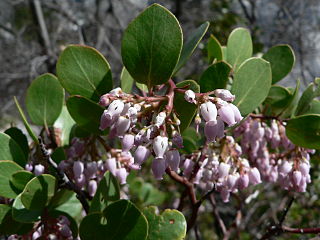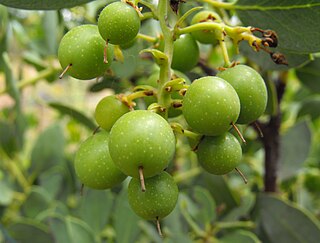
Arctostaphylos catalinae, known by the common name Santa Catalina Island manzanita, is a species of manzanita native to Southern California.

Arctostaphylos patula is a species of manzanita known by the common name greenleaf manzanita. This manzanita is native to western North America where it grows in coniferous forests at moderate to high elevations.

Arctostaphylos morroensis is a species of manzanita known by the common name Morro manzanita. This shrub is endemic to San Luis Obispo County, California, where it is known only from the vicinity of Morro Bay.

Arctostaphylos viscida, with the common names whiteleaf manzanita and sticky manzanita, is a species of manzanita.

Arctostaphylos pumila, with the common name sandmat manzanita, is a species of manzanita.

Arctostaphylos confertiflora is a rare species of manzanita known by the common name Santa Rosa Island manzanita. This shrub is endemic to California, where it grows on the sandstone bluffs of Santa Rosa Island in the Channel Islands. This manzanita is listed as an endangered species by the United States Government.

Arctostaphylos pallida, commonly known as pallid manzanita, Oakland Hills manzanita, and Alameda manzanita, is an upright manzanita shrub from the Ericaceae, or heath family. It is endemic to the eastern San Francisco Bay Area of Northern California.

Arctostaphylos bakeri is a species of manzanita known by the common name Baker's manzanita. It is endemic to Sonoma County, California, where it grows in the chaparral and woodlands of the North Coast Ranges. It is sometimes a member of the serpentine soils flora.

Arctostaphylos insularis is a species of manzanita known by the common name island manzanita. It is endemic to Santa Cruz Island, one of the Channel Islands of California.
Arctostaphylos luciana is a species of manzanita known by the common name Santa Lucia manzanita, is endemic to California.
Arctostaphylos malloryi is a species of manzanita known by the common name Mallory's manzanita. It is endemic to California.

Arctostaphylos nissenana is a species of manzanita known by the common name Nissenan manzanita. It is endemic to California, where it grows in the woodlands and chaparral of the Sierra Nevada foothills, mostly in El Dorado County.

Arctostaphylos obispoensis is a species of manzanita, known by the common names bishop manzanita and serpentine manzanita, endemic to California.

Arctostaphylos pajaroensis is a species of manzanita known by the common name Pajaro manzanita. It is endemic to California, where it is known mainly from Monterey County.
Arctostaphylos pilosula is a species of manzanita, known by the common names La Panza manzanita and Santa Margarita manzanita, that is endemic to California.

Arctostaphylos purissima is a species of manzanita known by the common name La Purisima manzanita.

Arctostaphylos refugioensis is a species of manzanita, known by the common name Refugio manzanita. It is endemic to Santa Barbara County, California, where it can be found along the immediate coastline, including the vicinity of Refugio State Beach, and into the Santa Ynez Mountains of the northwestern Transverse Ranges.

Arctostaphylos regismontana is a species of manzanita known by the common name Kings Mountain manzanita. It is endemic to California, where it is known from the northern slopes of the Santa Cruz Mountains in the southern San Francisco Bay Area.

Arctostaphylos rudis, with the common names Shagbark manzanita and Sand mesa manzanita, is a species of manzanita.

Arctostaphylos rainbowensis is a species of manzanita known by the common name Rainbow manzanita. It is endemic to California, where it is known only from northern San Diego and southern Riverside Counties in the Peninsular Ranges.


















